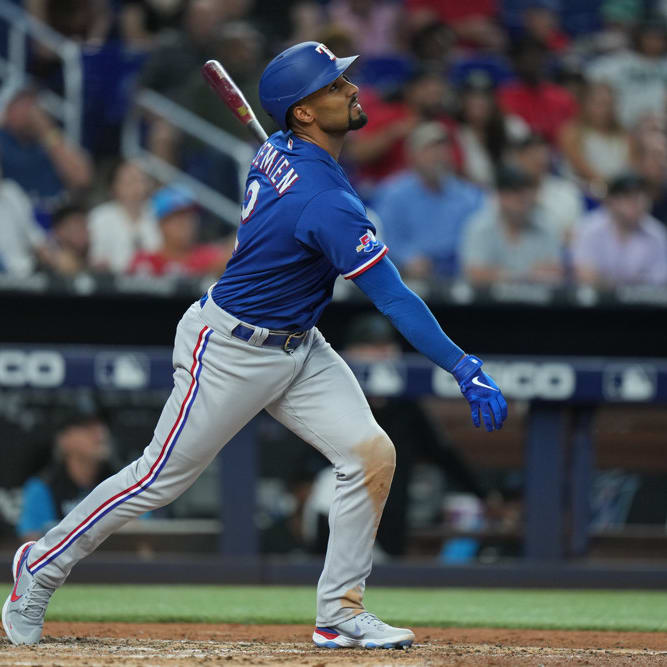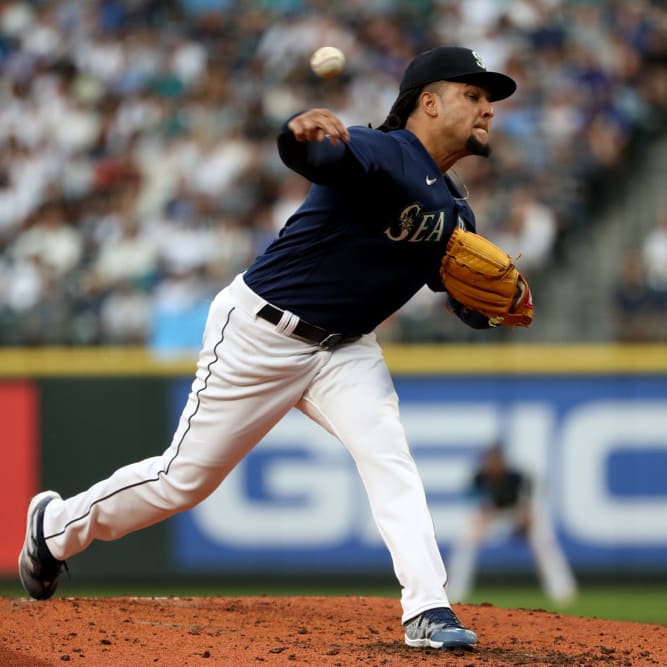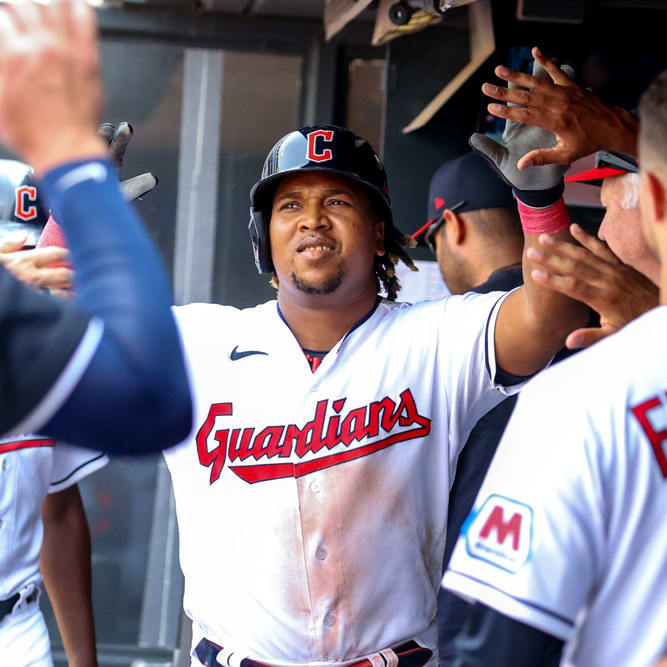Overvaluing Elite Starting Pitching
It seems I've been guilty of this. Here's how it happened:
I had Dalton Del Don on the Sirius XM show, and he remarked that he was going with starting pitchers in the first 3-4 rounds this year because a sharp owner in his league did that last year and won easily. Dalton wasn't sure why it worked, but speculated that maybe because you start only nine pitchers (as opposed to 14 hitters), it's easier to dominate pitching stats than hitting. In other words, you only need four or five high-quality draft picks to do so versus six or seven top hitters. Moreover, in a typical nine-man fantasy rotation, two are relievers, so essentially seven players get you four categories. Each pitcher is therefore four sevenths of a category vs. hitters who get you five fourteenths (14 players contributing to five categories).
That makes sense in theory, but what happens when you run the numbers on pitchers and hitters? When you project out all the stats, subtract out replacement value and figure out how many standard deviations above it each player is in each category, then how do elite starting pitchers compare to hitters?
Well it depends.
To convert your projections into dollar values you need to assign a total amount of money spent on the total number of players drafted. In a typical 12-team, $260 league with 23 players (14 hitters and nine pitchers) there are $3120 to spend on 108 pitchers and 168 hitters. Because pitchers and hitters each contribute to five categories, it makes intuitive sense to divide up the money 50/50, i.e., $1560 each. And at the end of the year if you want to figure out what players earned, that's exactly the right way to do it.
But on draft day - before you know exactly what these players will do - there's another variable: reliability. Because if, for example, hitter projections had no reliability, i.e., any hitter was as likely to do as well as any other, you'd be wise to spend $246 on pitching and buy 14 $1 hitters. Why spend more when the $1 guy is just as likely to be good as the $30 one? Thus, to the extent one set of categories (hitting) is more reliable than another (pitching), you'll want to spend more on it. And that's exactly what's happened. Pitching is considered less reliable so on average people spend on 30 percent of the $3120 ($936) on it, while hitting gets 70 percent ($2184). And this has a dramatic effect on auction values. Apportioning $936 among 108 pitchers will make them a lot cheaper than apportioning $1560 to them.
That the market has settled roughly on this 70/30 split is also meaningful because if it were totally wrong, it's likely people spending more on hitting (or pitching) would consistently win until others adapted and a new equilibrium were set. Of course, the process of the market finding the right balance can take time. If we're now in a new, pitching-friendly, post-steroid era, it's possible the optimal split has changed, and Dalton's friend was one of the first to take advantage of that.
So I set out to examine whether this change was happening. That's when I came across Peter Kreutzer's study suggesting top starting pitchers (those who cost $20 or more) were even slightly more reliable than top hitters last year. If that were the case - I wondered - then why are we pricing elite pitchers' stats with only 30 percent of the entire budget? Put differently, if the only good reason to discount pitchers is their relative lack of reliability, and a certain subset of pitchers - namely the elite ones - didn't have that problem, then perhaps we should price those top 10 or 15 starters at 50/50. So if Cliff Lee is worth $27 out of the $936 to be spent in the NL, he'd be worth $45 out of the $1560, i.e., his 50/50 price would be $45.
Even if we were to soften this massive raise due to Kreutzer's study comprising only one year, valuing Lee at $40 or even $38 means he's a massive profit at $27. (And if fact he went for just $23 in NL LABR.) As a result, I argued we should be targeting elite starting pitching as the expected profit should be massive, even if it meant drafting a slightly unbalanced team. To the extent elite starting pitching is heavily undervalued, every extra dollar spent on it is going to get you more pitching points (and trade surplus) than you're losing from missing out on hitting.
Of course, I wanted to make sure there wasn't some other good reason - aside from inferior reliability - for discounting pitching so I asked anyone I could to provide one. I heard the discount is due to having 14 hitting spots and only nine pitching ones. But that made no sense because if you had 90 hitter spots and nine pitching ones, you wouldn't spend only nine percent of your budget on pitching as it still comprises half your categories.
Kreutzer argued we pay less for elite starters than they earn in part because more free loot, i.e., undrafted postively-valued players, comes into the pool on the pitching side than on the hitting side. Because it's more likely cheap and undrafted pitchers can be impact players, you don't need to invest as much in the elite guys as you do with hitting.
But while it's undoubtedly true there's more free pitching loot, it's unclear the volatility at the bottom of the pitching pool negates the value of the stability at the top. While those $1 pitchers can earn $20 and become aces, they can also easily earn -$10 and negate the ones that did pan out. Moreover, those who buy elite pitchers are not precluded from speculating on $1 pitchers. One's net expected return from the bottom feeders is still negative (-36%), and that's even more the case with the mid-level ($10-$20) starters (-60%).
Because I didn't find a compelling reason for the 70/30 split other than reliability, and elite pitchers seemed to be at least as reliable as elite hitters, I decided the elite pitchers should be priced at 50/50 or no worse than 60/40.
In that case, your overall pitching values stay at 70/30 by moving the non-elite guys to 73/27 and the top few guys to 60/40 or 55/45. At those values, you'd wind up buying every elite pitcher you could possibly afford as they'd come at $10-$15 discounts.
So I was all set with my strategy this year until having a drink with Kreutzer and Derek Carty Thursday after lunch. Again I made my case for buying elite pitchers, wanting to hear a good reason why we should be attached to the 70/30 split into which everyone seemed to buy, and Peter said something about elite pitchers indeed holding up well at their 70/30 values.
And then it hit me: Peter's article that showed elite pitching reliability was based on 70/30 values! In other words, if you apportion only 30 percent of the budget to pitching, the elite ones go $20-$35 and do quite a good job (89 percent) of earning what they cost compared to hitters (82 percent). But if you were to price elite pitchers at 50/50, they'd go for $33-$58, and they would do an awful job of retaining value. Even at 60/40, the range goes from $27-$47, at which they'd still significantly underperform top hitters as a group.
So elite pitchers are ever-so-slightly more reliable than hitters only after they've been discounted for their unreliability with the 70/30 split. Because the market typically undervalues them at this split (Lee is worth close to $27, but went for $23 at LABR), and they were slightly more reliable than hitters last year, it's arguable you should still target whichever elite starter or two is cheapest. But in that case you're likely looking at a $2-$7 profit rather than a $10-$15 one.
That's not to say that the 50/50 split isn't completely accurate for determining how much your pitchers helped you at the end of the year - after all, they still comprise half your categories. But at that point we know who did well and who did not, something that's harder to discern with pitchers in the preseason and makes up the basis for their discount.












